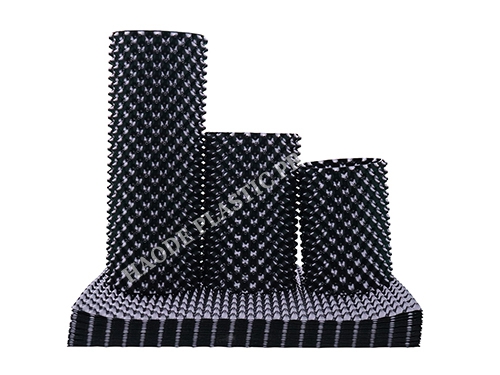The Principle and Applications of Root Control Containers: Key to Enhancing Plant Growth Efficiency
2024-08-23 10:02:17
In modern agriculture and horticulture, (also known as root control devices) have become crucial tools for improving plant growth efficiency. By optimizing the root environment, root control containers help plants better absorb nutrients and water, thereby enhancing plant health and yield. This article provides a detailed overview of the principles, applications, and key roles of root control containers in boosting plant growth efficiency.

1. Principles of Root Control Containers
1.1 Controlling Root Growth
The core function of root control containers is to regulate the direction and extent of root growth. By incorporating well-designed structures, these containers can guide roots to grow in specific directions, preventing excessive spreading or entanglement. This control promotes a more uniform root distribution in the soil, improving root absorption efficiency.
1.2 Improving Root Environment
Root control containers typically feature components that optimize the root environment, such as ventilation holes, drainage systems, and moisture-retentive layers. These features ensure that roots receive adequate oxygen and water, preventing issues like root rot or diseases caused by waterlogging or oxygen deprivation.
1.3 Promoting Root Health
By providing appropriate growth space and conditions, root control containers effectively reduce root crowding and entanglement, promoting healthy root development. Healthy roots are better able to absorb nutrients and water from the soil, supporting overall plant growth.
2. Applications of Root Control Containers
2.1 Commercial Agriculture
In commercial agriculture, root control containers are widely used for various crops, including vegetables, fruit trees, and grains. They help optimize root growth, enhance overall crop yield and quality, and reduce fertilizer and water consumption by improving root absorption efficiency in large-scale farming.
2.2 Greenhouse Cultivation
In greenhouse cultivation, root control containers improve the growth conditions for plant roots. Despite the controlled environment in greenhouses, root growth can still be limited. Root control containers ensure that roots grow healthily within the confined space, enhancing plant productivity.
2.3 Home Gardening
For home gardeners, root control containers help optimize small-scale planting environments. In limited spaces, these containers effectively manage root growth, enabling home gardeners to achieve better planting results. They also provide balanced nutrient supply in pots and gardens.
2.4 Hydroponic Systems
In hydroponic systems, root control containers play a crucial role. With roots suspended directly in nutrient solutions, these containers stabilize root growth and prevent entanglement and disease. They also optimize water flow and oxygen distribution, supporting healthy growth of hydroponic plants.
3. Key Roles in Enhancing Plant Growth Efficiency
3.1 Optimizing Nutrient Absorption
Root control containers improve the root environment, significantly enhancing the plant's ability to absorb nutrients from the soil. A well-distributed root system can more effectively access soil nutrients, supporting robust plant growth.
3.2 Reducing Disease Risks
Healthy roots help minimize the occurrence of root diseases. By providing suitable ventilation and drainage conditions, root control containers reduce root moisture, lowering the risk of pathogen development and enhancing the plant’s overall disease resistance.
3.3 Increasing Resource Utilization Efficiency
Root control containers help plants utilize water and fertilizers more efficiently. In large-scale agriculture, this increased efficiency reduces resource waste, thereby improving economic returns and environmental sustainability.
3.4 Promoting Balanced Growth
Root control containers ensure even root distribution, preventing root crowding and entanglement. This balanced growth condition supports overall plant development, leading to healthier roots and stronger plants.
Conclusion
Root control containers are essential tools for enhancing plant growth efficiency, with principles and applications spanning various aspects of modern agriculture. By controlling root growth, improving the root environment, and promoting root health, these containers effectively boost nutrient absorption, reduce disease risks, increase resource utilization efficiency, and ensure balanced growth. Understanding the principles and applications of root control containers will help you better utilize this tool in agriculture and horticulture, achieving more efficient and healthier plant cultivation.

The CNC Seed Braiding Machine is a high-precision, fully automated agricultural equipment s...

It adopts electrical integration and can be started by pressing the fully automatic button ...

The XP750 seeder has stable performance, excellent product quality, simple and convenient o...

It adopts electrical integration and can be started by pressing the fully automatic button ...



